Observatoire de Peking (c. 1790).
Work this week has necessitated going through more 19th-century journals. For a while now I’ve had some downloaded copies of Scientific News, a kind of London equivalent of Scientific American, but I hadn’t noticed this particular article until I had to look through it again. The uncredited piece describes the ancient astronomical instruments at the observatory in the heart of Beijing, China (or “Pekin” as they have it here). Armillary spheres always catch my attention, and the Beijing ones are splendid examples supported by ornamental dragons. The text is informative but also mildly condescending as most discussion of China or Japan at this time tended to be. The piece includes some nice engraved illustrations of the instruments (scroll down), all of which can still be seen today surrounded by a city which the Chinese of 1888 would no longer recognise.
* * *
ASTRONOMY IN CHINA: THE PEKIN OBSERVATORY
VICE-ADMIRAL MOUCHEZ has just received from Pekin, for the Astronomical Museum which he has founded in connection with the Observatory of Paris, a series of photographs representing the Pekin Observatory and the instruments there erected. By the courtesy of our contemporary La Nature we are enabled to place these curious views before our readers, and thus give them an exact idea of the present state of astronomy in the nation which has cultivated it with the greatest zeal, for the longest time, and among whom it has received the most remarkable developments.
Astronomical functions have not ceased to be held in honour in China, and the Observatory of the Celestial Empire is at present under the direction of an uncle of the Emperor, who ranks as the fifth prince of the blood, and bears the title of Chancellor.
The number of persons attached to this establishment is more considerable than that at Paris. It amounts, including students, to 196. The chief functionaries after the Chancellor are a Chinese director and a Tartar director, having the right to wear a button of a precious stone, and to bear on the chest the image of a sea-raven. Then follow two sub-directors, one Chinese and one Tartar, and two assistants entrusted with calculations. These latter, prior to the expulsion of the Jesuits, were always foreigners. Two other functionaries require to be noted. The first is the keeper of the buildings, and the second the custodian of the water-clocks, as chronometers have not been as yet introduced into the observatory, any more than have telescopes.
The calculators of the Observatory possess tables constructed or rectified by the Jesuits in the seventeenth century, which are used in their calculations, and which they keep carefully hidden. Hence, contrary to the general principles of the Chinese Government, the astronomical functions have become hereditary. But on the other hand, they are purely honorary.
The strictly scientific functions are not very difficult to execute, since in Pekin itself there are some private observatories attached to the European embassies. Besides, the missionaries have organised at Zi-ka-wei an observatory of the first rank, where all the modern methods are carried out with carefully selected instruments. This establishment is situate at 800 kilometres to the south-east of Pekin, in the neighbourhood of Shanghai. The astronomers of the Chinese Government can thus, with little trouble, carry on the conversion of the calculations.
But they have also to discharge a more delicate function, in which they cannot be assisted by European savants. This is to determine the lucky and unlucky days, an operation of the greatest importance in a country where a faith in astrology is universal. They have, besides, like the ancient Augurs of Rome, to consult omens, which they do in a manner showing great simplicity.
The council of the Observatory of Pekin meets in full conclave on the evening of the last day of the year, and remains sitting until midnight, when the new year begins. At this moment the astronomers look from what quarter the wind blows, which they ascertain by means of sacred banners set up for the purpose. On February 14th, 1888, at the beginning of the twenty-fifth year of the seventy-sixth cycle, which is not yet completed, they ascertained that the wind was north-east, a point considered as the most favourable omen. They drew hence the conclusion that all kinds of felicity might be expected during the next twelve months.
The observatory is placed on a terrace of some yards in height, and of a square form, situated along the fortifications of Pekin. It is traversed by a tunnel, through which passes the road, and in case of need it could be utilised for the defence of the city.
Our figure No. 1 shows this terrace with the collection of instruments which the Chinese astronomers use, or are supposed to use, in their observations. The other figures show in detail the manner in which they are constructed. Fig. 2 gives an idea of the luxury and art with which some of the instruments are mounted.
Father Lecomte, who had to manage these instruments at the end of the seventeenth century, says that the workmen who executed them had been much more concerned with the perfection of the figures of dragons with flames issuing from their throats than with the accuracy of the graduations. He thinks that a quadrant of eighteen inches executed at Paris by the opticians of his time would give more useful results than the great six-foot circle executed at Pekin. The limb is divided into graduations of ten minutes, which is the limit of accuracy attainable if the graduation had been carefully executed, and if the instrument had been fitted with sights.
Father Lecomte describes the installation of a quadrant of a very careful construction, probably the one which Louis XIV sent to the Emperor Kang-hi.
The lead which marks its vertical position weighs a pound, and hangs from the centre by means of a delicate copper wire. The index is movable and slides freely on the limb. A dragon, coiled up and surrounded with clouds, comes from every side to seize the bands of the instrument, lest they might move out of their plane. The entire body of the quadrant is in the air, traversed by the centre of an immovable axle, upon which it turns towards those parts of the heavens which are to be observed. Because its weight might cause some oscillation, or cause it to leave its perpendicular position, two shafts are placed at the sides. They are secured at the bottom by two dragons, and connected to the middle shaft by clouds which seem to descend from the air.
Fig 3. shows that for observations the Chinese astronomers make use of a ladder on rollers, analogous to those employed in European observatories, and moving upon a double rail. But we must not honour the Chinese imagination for this improvement, for the ladder appears of recent construction, so has probably been imported from Europe.
There are, further, upon the terrace an armillary sphere, an equinoxial sphere, and a celestial sphere of six feet in diameter (fig. 4). This last instrument attracted the admiration of Father Lecomte, and is, in fact, very remarkable. All the stars are shown in relief in their proper places. It is so well suspended that a child could turn it in the direction of the diurnal movement, though it weighs 2,000 lbs.
He describes the ornaments shown in the figure, and the concealed wheel-work which gives the axle any desired inclination.
One of the most remarkable instruments is the gnomon, analogous to that used by Kuo-Shou King, astronomer to the Emperor Kublai Khan, founder of the first Tartar dynasty and creator of the first Tartar dynasty. This astronomer used it for executing certain observations, of which Laplace speaks in laudatory terms in his Mécanique Celeste.
In addition to the instruments just named, we figure a very ancient armillary sphere dating back to the thirteenth century (fig. 5). The inevitable bronze dragons supporting it are remarkable for their delicacy of execution. Father Verbiest effected a reorganisation of the observatory in 1670, very near the time (1667) when Dominic Cassini created the Observatory of Paris for Louis XIV. He removed the instruments of Kuo-Shou King, most of which still exist, and which have been recently photographed. They differ from those of Father Verbiest chiefly by their profusion of ornaments and by being less easily handled. They are graduated in 365 degs., so that the sun traverses daily one of their degrees. They are similar to those which Tycho constructed at his observatory in the Isle of Huen, with which he observed up to the end of the sixteenth century. They only differ from modern instruments because in these latter the sights have been replaced by telescopes which the Chinese do not want, and of which they have no need – Father Verbiest, the second creator of the Observatory of Pekin, died in that city exactly two centuries ago. •
Scientific News, December 14th, 1888
Previously on { feuilleton }
• Jaipur Observatory panoramas
• The Jantar Mantar

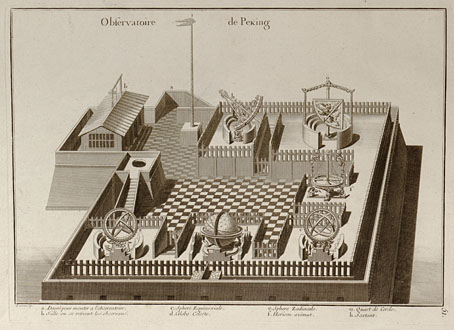
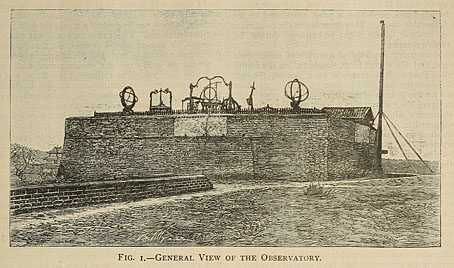
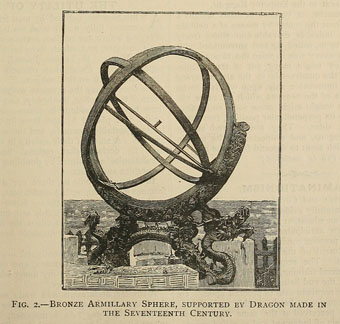
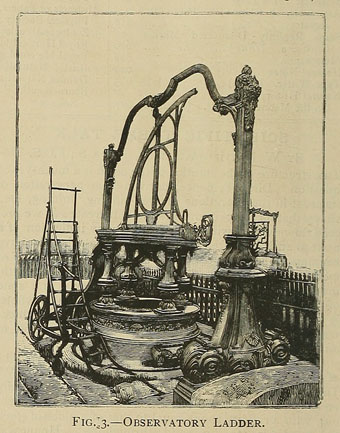
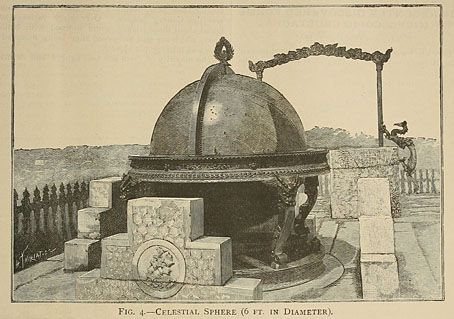
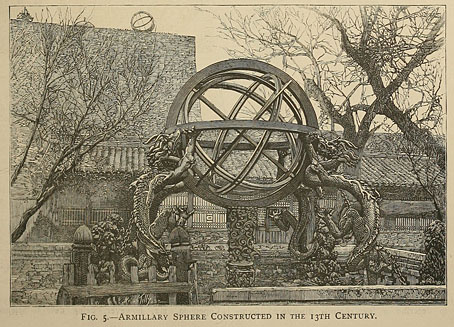
The top image looks like a Paul Noble drawing!
http://butdoesitfloat.com/filter/paul-noble
Ha, yes, it does.